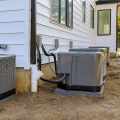Your HVAC thermostat is a great way to regulate the temperature inside your home. But what are the five main components that make up your HVAC system? In this article, we'll discuss the heat exchanger, fan motor, combustion chamber, evaporator coil, and condenser. Let's take a closer look at each of these components and how they work together to keep your home comfortable.\The heat exchanger is an essential part of your furnace. It is responsible for meeting its heat needs by heating the air when the thermostat detects that the ambient temperature has fallen below the defined level.
This component is made of durable stainless steel to prevent cracking and other damage. Some even have a special duct to increase system efficiency. Heat exchanger breakdowns can lead to hazardous situations such as carbon monoxide leakage, which can cause nausea, headaches, and even death in extreme cases. To avoid these risks, it's important to have a professional technician maintain your heating and air conditioning system in Fort Worth, Texas.\If your system has a variable speed motor, it will run at different speeds at different times depending on your home's heating needs.
This increases the efficiency of the system and reduces electricity bills. Additionally, this engine gradually gains speed, reducing system noise. It is also very useful for removing moisture during the summer season. To maximize efficiency and reduce energy bills, we suggest upgrading the fan motor of your heating and air conditioning system in Fort Worth, Texas.\The combustion chamber or burner is the component in which your furnace provides oxygen to the fuel to improve its combustion.
The system cycle begins when a gas-air mixture enters the combustion chamber. A glowing bar or pilot light is turned on and burns this mixture in the presence of more air flowing to the burner.\Your HVAC system's evaporator coil is placed inside your indoor air handler. Its unit converts coolant from liquid to gaseous by spraying it from a series of expansion valves or small nozzles. This gas absorbs heat from your home and lowers your temperature.
The compressor is also an important part of the air conditioning unit; it does most of the work but many system problems do not originate from it. When a premature compressor failure occurs, it often means that there is another problem that has gone unnoticed.\The air conditioning in a commercial HVAC system is very similar to that of a residential unit. Its purpose is to dehumidify the air and remove heat; however, it does not cool the building itself but works with many other subsystems to regulate temperature.\The condenser is the heat exchanger that serves as the hot side of the air conditioning unit. It removes heat from the building and transfers it to the outside.
The gaseous refrigerant is then converted to liquid refrigerant. A heat pump can also have a condenser, in which case it works to collect heat from the outside.\The expansion valve is an essential part of the condenser's function. It removes the pressure of the liquid refrigerant to cause expansion, converting the substance from liquid to vapor. The expansion valve provides precise control of the flow of refrigerant to the evaporator coil.\Of all the different parts of the air handler, the evaporator coil is most likely to need maintenance or replacement.
The evaporator coil contains cold refrigerant received from the compressor. As air from the fan moves over the coil, heat is removed from the air in the treated area.\Chillers come in air-cooled and water-cooled varieties. Its function is to remove heat from liquid that circulates through pipes in a structure. In an air-cooled chiller, condenser coils are cooled with air driven by a fan and are usually located outdoors.\The main unit of an HVAC system includes an air conditioner, heat pump, or oven; these are where heating and cooling take place with help from other internal and external mechanics.\The heat generator is a key component of an HVAC system when it comes to heating.
What happens in these devices is energy extraction from fuel inside a furnace (also known as a combustion chamber). The hot flue gases will then heat air or other fluid (such as water) which will then heat air entering conditioned environment. Electrical heat generation could also be used for heating up an air conditioner. While there can be various options for heat generators, furnaces are most common forms so it's important to consider combustion efficiency for resource control and emission of contaminants for environmental reasons related to these components of an HVAC system.
Since most heat generators burn fuel as energy source, safety considerations must be taken into account due to combustion systems operating mainly with excess air to lower combustion temperature and produce fewer NOx emissions; carbon monoxide would be one of reaction products. Therefore, safety problem for heat exchangers would be leakage of carbon dioxide into air passing through flue gas tubes; carbon monoxide being colorless and odorless gas can cause headaches, dizziness, nausea and even death at high levels so detectors must also be arranged for controlling such leaks. One of components of air conditioning system called fan passes air through heat exchanger into air duct carrying hot air towards its destination; fan being driven by electric motor through shaft with adjustable speed depending on engine speed; such motors must be variable speed type with variable speed motor blowers reaching optimal performance.










